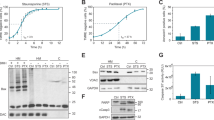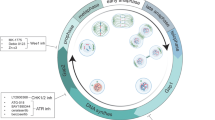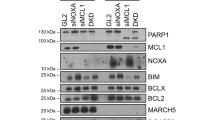Abstract
The antimicrotubule anticancer drug, Taxol, suppresses microtubule dynamics, causes mitotic arrest, and induces caspase-3 cleavage and activity resulting in apoptosis of human AML HL-60 cells. Caspase-3 cleavage is triggered by the mitochondrial release and cytosolic accumulation of the electron transfer protein, cytochrome c (cyt c). Taxol-induced G2/M transition is mediated by p34cdc-2 (CDK1) which, if prematurely activated, may also trigger apoptosis. In the present studies following S-phase synchronization and release, HL-60 cells with enforced expression of the bcl-xL (HL-60/Bcl-xL) and/or neomycin resistance gene (HL-60/neo) were exposed to Taxol to examine CDK1-related cell-cycle events and the cyt c-triggered molecular cascade of apoptosis. At various time-intervals after Taxol treatment, immunoblot analyses of cyclin B1 and CDK1 levels were performed. In addition, the in vitro histone H1 kinase activity of immunoprecipitated CDK1 and its tyrosine phosphorylation status (by anti-phosphotyrosine immunoblot analysis) were determined. Data presented here show that, while Taxol-induced peak CDK1 kinase activity occurs earlier in HL-60/neo cells, there are no significant differences in cyclin B1 accumulation, tyrosine dephosphorylation of CDK1, and mitotic arrest of Taxol-treated HL-60/neo vs HL-60/Bcl-xL cells. Taxol-induced CDK1 activation and mitosis preceded the cytosolic accumulation (six-fold) of cyt c. The latter event was blocked by Bcl-xL overexpression but not by inhibitors of caspase-3. Although the caspase inhibitors and high Bcl-xL levels inhibited caspase-3 cleavage and activity, they did not significantly affect Taxol-induced CDK1 activation or mitotic arrest. These findings indicate that Bcl-xL overexpression does not affect Taxol-induced CDK1 activity leading to G2/M transition, which temporally precedes the cytosolic cyt c-mediated cleavage and activity of caspase-3 and apoptosis.
This is a preview of subscription content, access via your institution
Access options
Subscribe to this journal
Receive 12 print issues and online access
$259.00 per year
only $21.58 per issue
Buy this article
- Purchase on Springer Link
- Instant access to full article PDF
Prices may be subject to local taxes which are calculated during checkout
Similar content being viewed by others
Author information
Authors and Affiliations
Rights and permissions
About this article
Cite this article
Ibrado, A., Kim, C. & Bhalla, K. Temporal relationship of CDK1 activation and mitotic arrest to cytosolic accumulation of cytochrome C and caspase-3 activity during Taxol-induced apoptosis of human AML HL-60 cells. Leukemia 12, 1930–1936 (1998). https://doi.org/10.1038/sj.leu.2401218
Received:
Accepted:
Published:
Issue Date:
DOI: https://doi.org/10.1038/sj.leu.2401218
Keywords
This article is cited by
-
Effects of paclitaxel on permanent head and neck squamous cell carcinoma cell lines and identification of anti-apoptotic caspase 9b
Journal of Cancer Research and Clinical Oncology (2016)
-
The newly synthesized 2-arylnaphthyridin-4-one, CSC-3436, induces apoptosis of non-small cell lung cancer cells by inhibiting tubulin dynamics and activating CDK1
Cancer Chemotherapy and Pharmacology (2015)
-
Prometaphase arrest-dependent phosphorylation of Bcl-2 and Bim reduces the association of Bcl-2 with Bak or Bim, provoking Bak activation and mitochondrial apoptosis in nocodazole-treated Jurkat T cells
Apoptosis (2014)
-
Tripeptidyl peptidase II in human oral squamous cell carcinoma
Journal of Cancer Research and Clinical Oncology (2013)
-
RanBP1 downregulation sensitizes cancer cells to taxol in a caspase-3-dependent manner
Oncogene (2009)



